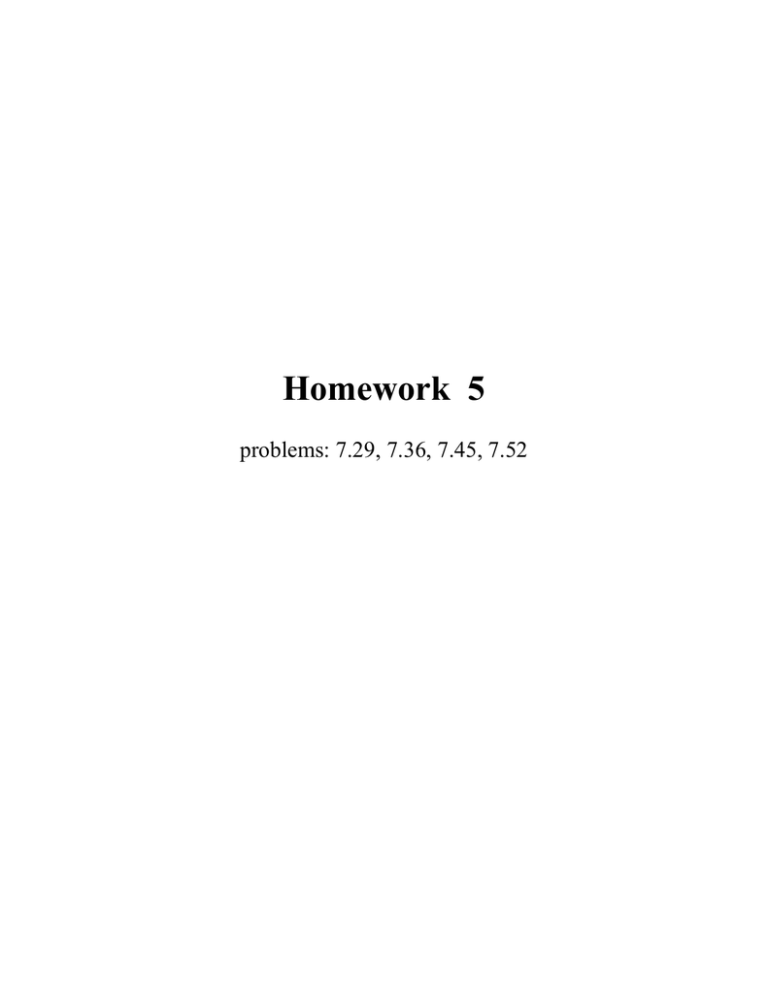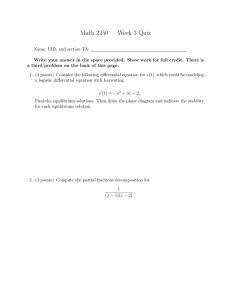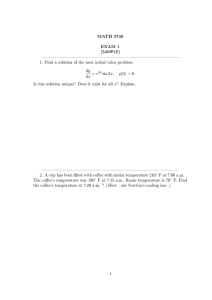Homework 5
advertisement

Homework 5 problems: 7.29, 7.36, 7.45, 7.52 Problem 7.29 A small particle of mass m is pulled to the top of a frictionless half-cylinder as illustrated in the figure. (a) Assuming that particle moves at a constant speed, show that F = mg cos θ. Note: If the particle moves at constant speed, the component of its acceleration tangent to the cylinder must be zero at all times. (b) By directly integrating W = ∫ F ⋅ dr , find the work done in moving the particle at constant speed from the bottom to the top of the half-cylinder. F T N Force F causes tension in the string dr m and the tensile force exerted on the θ R particle. Hence the tangential mg θ component of the tensile force T is equal to the magnitude of force F. Since the particle moves with a constant speed, the tangential component of the acceleration is zero. Assuming inertiality of the reference frame, Newton’s second law of motion requires that the tangential component of the net force has a zero value. Since the normal force N is perpendicular to the cylinder’s surface, tangential component of the weight mg must be opposite to the tensile force F = T = mg cos θ Directly from the definition, the differential amount of work, dW, done on the particle due to the tensile force, is proportional to the differential displacement of the particle dW = F ⋅ dr = mg cos θ ⋅ dr ⋅ cos 0 In order to find the work over the entire path, all differential contributions must be added (integrated). The rest is math. There are two variables in the differential (r and θ). It does not matter with of the variable is selected for performing the integration but consistently the other variable must be related to the integration variable. For example relating the length of the differential path as dr = R ⋅ dθ W= π/2 π/2 ∫ F ⋅ dr = ∫ mg cos θ ⋅ R ⋅ dθ = mgR ⋅ sin θ 0 path 0 = mgR Problem 7.36 2.8 cm In an electron microscope, as well as in a cathode ray tube of a TV set, there is an electron gun that contains two charged metallic plates 2.8 cm apart. An Fel electric force accelerates each electron in the beam from rest to 9.6% of the speed of light over this distance. (a) Determine the kinetic energy of the electron as it leaves the electron gun. Electrons carry this energy to the phosphorescent material on the inner surface of the viewing screen where the image is formed. For an electron passing between the plates in the electron gun, determine (b) the magnitude of the constant electric force acting on the electron, (c) the acceleration, and (d) the time of flight. a) From its definition, the kinetic energy of electrons leaving the gun is ( mv 2 9.1 ⋅ 10 − 31 kg ⋅ 0.096 ⋅ 3 ⋅ 108 m / s K2 = = 2 2 )2 = 3.77 ⋅ 10−16 J b) In the electron gun there is only one significant force exerted on the electrons in the beam: the electrostatic force. Hence the net force is equal to the electrostatic work. The electrostatic force between the plates is constant, which simplifies the calculation of the work ΔW = F ⋅ D = FD cos 0 = FD Following the work-energy theorem and the fact that the initial kinetic energy of an electron was zero, the electrostatic work performed on the electron is equal to the kinetic energy found in part (a). Hence ΔW ΔK K 2 3.77 ⋅ 10 −16 J F= = = = = 1.35 ⋅ 10 −14 N D D D 2.8 ⋅ 10 − 2 m c) According to Newton’s second law of motion, the magnitude of the electron’s acceleration is Fnet Fel 1.35 ⋅ 10 −14 N m a= = = = 1.48 ⋅ 1018 m e m e 9.1 ⋅ 10 − 31 kg s2 d) In this motion (along straight path with constant acceleration) the travelled distance is a quadratic function of time. Solving for time t= 2D 2 ⋅ 2.8 ⋅ 10 − 2 m = = 1.9 ⋅ 10 −10 s = 0.19ns 18 2 a 1.48 ⋅ 10 m / s Problem 7.45 A force acting on a particle moving in the xy-plane is F = (2yi + x2j) N, where x and y are in meters. The particle moves from the origin to a final position having coordinates x = 5 m and y = 5 m, as in Figure P8.21. Calculate the work done by F (its source) along (a) OAC, (b) OBC, (c) OC. (d) Is the force conservative or nonconservative ? (e) Explain your answer to part (d). y a) We can find the work directly from the definition r r W = ∫ F ⋅ dr 1) B C path For simplicity's sake, I will not write the units but I will take care to use SI units only. x O A We can express the scalar product in the above integral in terms of the scalar components of both vectors. It also would be convenient to separate the integration into an integral along segment OA and an integral along segment AC ( ) OAC = ∫ (Fx dx + Fydy + Fz dz ) + ∫ (Fx dx + Fydy + Fz dz ) = WOAC = ∫ Fx dx + Fydy + Fz dz = 2) OA AC = WOA + WAC Along path OA the differential displacement vector has two zero components (dy = 0 and dz = 0). According to the given expression, the scalar components of the force along this segment are F = [0,x2,0]. The work done along this part is therefore 3) WOA 0 0 ⎛5 ⎞ = ⎜⎜ ∫ 0dx + ∫ 0dy + ∫ 0dz ⎟⎟ = 0J ⎝0 ⎠ 0 0 Along AC, the differential displacements are in the y-direction (dx = 0 and dz = 0). The scalar components of the force along this segment are F = [2y,x2,0]. Therefore the work done along this part is 4) 5 5 0 5 0 0 WAC = ∫ 2 y( x )dx + ∫ 25dx + ∫ 0dz = 125J The work along path OAC is 5) b) WOAC = 0J + 125J = 125J The calculation for path OBC is very similar ( ) OBC = ∫ (Fx dx + Fydy + Fz dz ) + ∫ (Fx dx + Fy dy + Fz dz ) = WOBC = ∫ Fx dx + Fy dy + Fz dz = 6) OB BC = WOB + WBC Along path OB the differential displacement vector has two zero components (dx = 0 and dz = 0). According to the given expression, the scalar components of the force along this segment are F = [2y,0,0].. The work done along this part is zero 7) 5 0 ⎞ ⎛0 WOB = ⎜⎜ ∫ 2 y( x )dx + ∫ 0dy + ∫ 0dz ⎟⎟ = 0J ⎠ ⎝0 0 0 Along BC, the differential displacements are in the x-direction (dy = 0 and dz = 0). The scalar components of force along this segment are F = [10,x2,0]. Therefore the work done along this part is 8) 5 5 0 5 The work along path OBC is 9) 0 WBC = ∫ 10dx + ∫ (x ( y) ) dy + ∫ 0dz = 50J 2 WOBC = 0J + 50 J = 50J 0 c) Along path OC the displacement has two nonzero components (dz = 0). Additionally both the y- and x- components of the differential fragments are related y(x) = x and x(y) = y 10) Taking equation (6) into account the scalar components of the force along this segment are F = [2x,y2,0] 11) Therefore, 12) WOC 5 0 ⎛5 ⎞ x2 = ⎜⎜ ∫ 2xdx + ∫ y 2dy + ∫ 0dz ⎟⎟ = ⎝0 ⎠ 2 0 0 x f =5 x i =0 y3 + 3 y f =5 + 0 = 66.7J yi =0 d,e) The force is nonconservative because the work done by the force depends on the path. Problem 7.52 For the potential energy curve shown in Figure P8.45, (a) determine whether the force Fx is positive, negative or zero at the five points indicated. (b) Indicate points of stable, unstable, and neutral equilibrium. (c) Sketch the curve Fx versus x from x = 0 m to x = 8 m. U(x) J From the definition of potential energy and the definition of work, we A 4 E can relate the force at each point of B 2 space with the position dependence of D the potential energy at the vicinity of 0 x (m) 2 4 6 8 this point. Consider a virtual -2 differential motion along the x-axis. C The work, related to the change in the -4 potential energy, done by the force depends on the component of the force along this displacement (differential) Fx dx = dW = −dU . (1) Therefore Fx = − (2) A B C D E slope none down none up none ∂U ∂x Fx 0 >0 0 <0 0 a) Whenever the derivative of the potential energy with respect to a coordinate is positive, the component of the conservative force is negative and vice versa. From the geometrical interpretation of the derivative we can analyze the slope of the plot. b) Any movement from stable equilibrium results in a restoring force opposite to the displacement from the equilibrium. Consistent with equation (1), this happens at locations where the object has the lowest potential energy (local minimum). At point C, the particle is at a stable equilibrium. Any movement from an unstable equilibrium results in a force directed away from the equilibrium position. Consistent with equation (1), it happens at locations where the potential energy of the object is at local maximum. Points A and E are unstable equilibrium locations for the particle. A displacement from a neutral equilibrium does not produce any force. Consistent with equation (1), the potential energy is constant in the vicinity of a neutral equilibrium. No neutral equilibrium exists in this case. c) Consistent with equation (1), we have to sketch the plot of the function opposite to the derivative of the function given in the problem. Whenever the function, representing the potential energy, has a maximum or minimum, the component of the force has zero value. At the steepest region the component of the force reaches its extreme values. Fx (x) J 4 2 0 -2 -4 C A 2 4 E 6 8 x (m)




